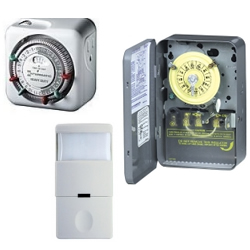
There is almost no better feeling than to be in total control of the way your money is spent, agreed? It is very much possible to get this feeling each time the energy bill arrives. I know this sounds crazy. After all, who likes to look at bills? However, installing a programmable timer in your home will give you control over the appliance it is connected to, which will decrease energy consumption, which in turn makes paying energy bills a task that is completed with much less frowning.
Getting the Most Out of an Appliance
Heating and cooling requires the most residential energy, and accounts for more than half of utility costs in the typical household, as much as $680 annually. While weatherproofing the home is a great way to reduce both consumption and costs, it can be costly depending on the scale of the insulation project. An appliance timer is a quick and cost-effective solution to this costly problem.
An appliance timer is plugged into a standard 120 volt, 3-prong wall receptacle. This timer allows up to 2 on/off settings per day. The green and red trippers on the timer indicate when the appliance will be turned on (green), and when it should be off (red). The timer is intended for use over the following appliances:
- Heaters
- Air conditioning systems
- Heavy duty appliances
- Heavy duty lamps
Saving on Water Heating
The water heater is a great appliance. It supplies heated water to every corner of the home that needs it. What isn’t so wondrous about it is that it runs all day, whether or not you need it to, maintaining the water temperatures. This is how water heating is easily follows heating and cooling as the next largest utility cost in the average home.
A water heater timer allows you to program the water heater on your schedule. It is for use with water heaters that run on 240 volts. The timer provides a maximum of 42 off/on settings per week, or 6 off/on daily operation settings. Installation is simple, and this type of programmable timer is able to work with your current system. To get the most out of this timer, it is best used:
- When the home is empty
- During peak hours
- At night when everyone is asleep.
Taking Complete Control of Lighting
Do you know how many lights there are inside your home? Now think about how often the lights are left on (including over night for security reasons in some cases). With the average home containing approximately 30 light fixtures, lighting is the next highest consumer of energy, and the next place you want to install a programmable timer.
The easiest way to regain control over the way lights are used in your home is to install an occupancy sensor. Not to be confused with a motion sensor, which controls lights solely based on movement in a room, an occupancy sensor detects body heat, turning lights on and off based on the vacancy of a room. The great thing about this type of timer is its ability to operate with LED, compact fluorescent, and incandescent lighting, eliminating the need to get rid of the lights you currently have. It has the ability to cover 20 feet to the side and 40 feet ahead, and provides many options for saving:
- Lights can be turned off between 30 seconds to 30 minutes after the last person has left a room.
- “Manual-on” with automatic turn off
- Ambient light sensor adjusts for light sensitivity
By reducing the power load from one or all of these sources, you will immediately begin to save energy and money without making a major change to your home. Bottom line: installing a programmable timer will help make your life a little easier and your wallet a little heavier.
